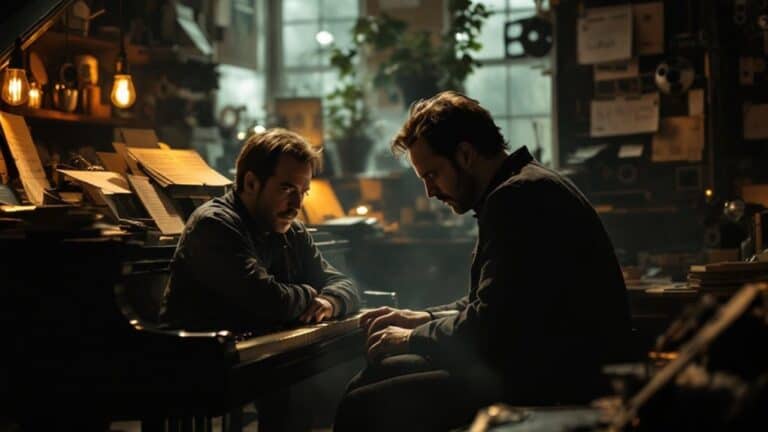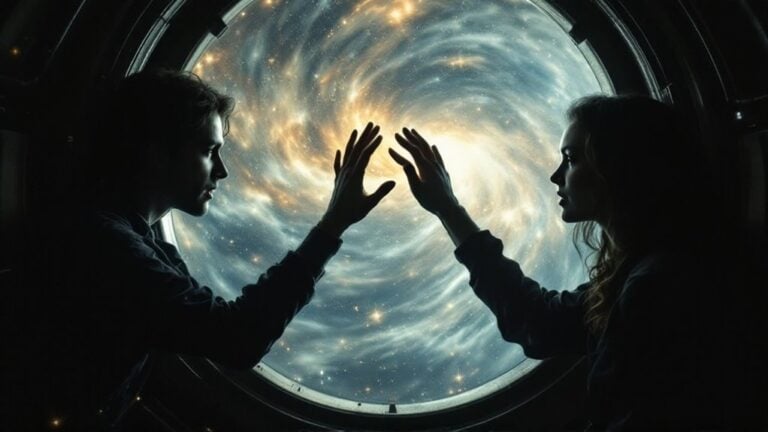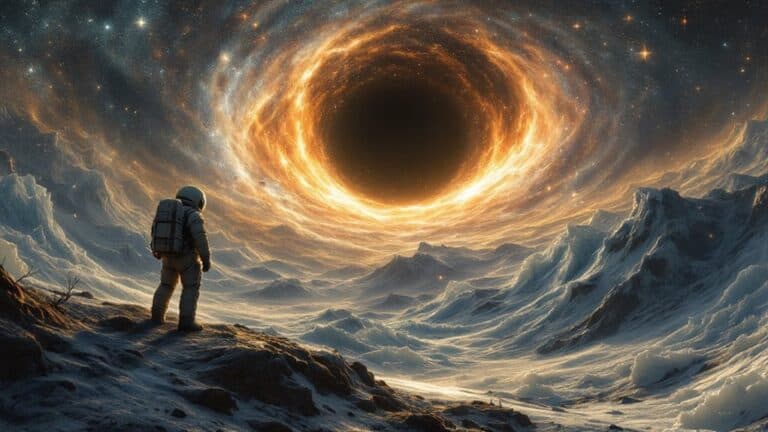Decoding Cooper and Murph’s Father-Daughter Bond in Interstellar
In *Interstellar*, Cooper and Murph’s bond serves as a profound emotional core, emphasizing love’s enduring power through time and space. You see their relationship evolve amid the tragic effects of time dilation, where each hour Cooper spends on missions translates to years lost for Murph. This dynamic fuels their personal growth, as Murph shifts from anger to determination, reflecting the pain of separation and the impact of sacrificial love. Ultimately, their reunion highlights the transformative nature of their connection, inviting you to reflect on how love shapes identity and choices across impossible distances. There’s much more to uncover.
Table of Contents
Key Takeaways
- The bond between Cooper and Murph is rooted in love, showcasing its power to endure despite physical and temporal separations.
- Time dilation creates emotional strain, with significant missed milestones impacting their relationship and communication.
- Cooper’s sacrifices for humanity’s survival highlight parental love, contrasting personal desires with the greater good.
- Murph’s transformation from anger to determination illustrates the complexity of their relationship and her growth as a physicist.
- Their eventual reunion underscores love’s healing power, emphasizing the resilience and significance of their father-daughter bond.
Emotional Connection Between Cooper and Murph
The father-daughter bond between Cooper and Murph serves as the emotional core of *Interstellar*. Their relationship exemplifies complex bond dynamics, showcasing how love can endure through space and time.
From the moment Cooper leaves Earth, you sense the tension that arises, revealing the depths of their emotional resilience. Cooper’s sacrificial decision to undertake a perilous journey for humanity highlights the strength of a love that transcends dimensions, while also laying the groundwork for their character development. The theme of faith amidst dire circumstances underscores their determination to hold onto hope despite the vastness of space separating them. Additionally, their journey reflects the film’s exploration of humanity’s struggle for survival, emphasizing the stakes of their emotional connection. This emotional depth resonates with audiences, contributing to the film’s recognition as a modern classic in science fiction.
Murph’s struggle with abandonment evolves into a profound understanding of her father’s choices, illustrating her growth and the healing power of forgiveness. This emotional connection resonates deeply, particularly during their final reunion, where both characters find closure and a sense of belonging.
The symbolic elements, like the bookshelf and Morse code communication, further emphasize their unique bond, reflecting how love can manifest in various forms.
Together, they navigate the complexities of conflict and reconciliation, ultimately showcasing that even in the face of immense challenges, the love between a father and daughter can remain a guiding light, illuminating the importance of sacrifice, understanding, and connection in a vast universe.
Narrative Role of Their Relationship

At the heart of *Interstellar*, the bond between Cooper and Murph drives the narrative forward, weaving their personal stakes into the fabric of the film’s larger themes. Their relationship serves as a vital foundation for narrative progression, showcasing how fatherly love shapes not only their lives but also the trajectory of humanity’s future.
Cooper’s decision to initiate on the perilous space mission stems from his desire to secure a better life for Murph, highlighting the selflessness inherent in parental love. His motivations are further complicated by a society that has devalued knowledge and technology, focusing instead on subsistence farming. This tension reflects the theme of character conflict where Cooper’s aspirations clash with the harsh reality of their world. Additionally, the film emphasizes the importance of love and relationships as central themes, impacting decisions and actions throughout the narrative.
As Murph grows, her connection to her father influences her evolution into a brilliant physicist, underscoring how their bond transcends both time and space. The film intricately portrays their love as a guiding force, motivating choices that echo throughout the story, even in the face of intimidating challenges.
Murph’s relentless pursuit to reunite with Cooper encapsulates an enduring hope that resonates deeply with viewers, reminding us of the profound impact relationships have on our identities.
Ultimately, the father-daughter dynamic not only enriches the emotional landscape of *Interstellar* but also illuminates the film’s exploration of love, sacrifice, and the ties that bind us, even across vast distances.
Time Dilation and Its Effects
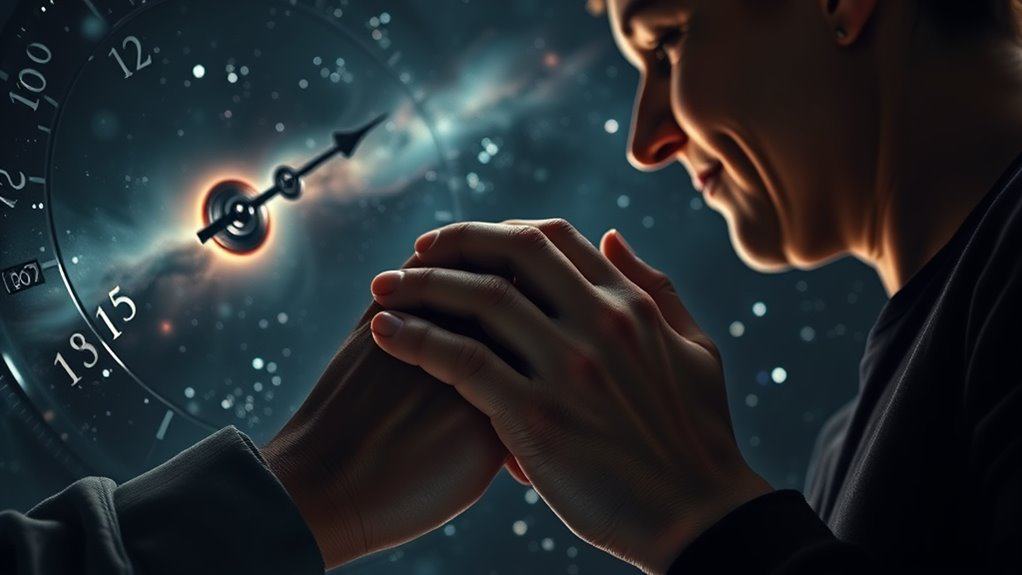
Time dilation isn’t just a scientific concept; it profoundly shapes the emotional landscape of Cooper and Murph’s relationship in *Interstellar*.
As Cooper ventures into the depths of space, the stark reality of time passing differently for him and Murph creates an aching distance that resonates throughout their bond. This phenomenon of time dilation not only complicates their communication but also heightens the stakes of their emotional connection, making every moment they share feel both precious and painfully fleeting. The challenge of severe communication blackouts complicates their ability to maintain a consistent relationship, further intensifying the emotional weight of their separation. This is exemplified by gravitational time dilation experienced near Gargantua, where mere hours for Cooper translate into decades for Murph.
Time Dilation Explained
Experiencing time dilation can feel like stepping into a science fiction narrative, where time behaves unpredictably based on your speed or proximity to massive objects.
In the domain of physics, time dilation refers to the phenomenon where a clock appears to tick slower when observed from a different frame of reference, especially at high speeds or near massive bodies. For example, while a muon traveling at 0.950c lives only 2.20 microseconds in its own frame, it seems to last longer to someone on Earth. This phenomenon is mathematically expressed by the equation (Delta t = gamma Delta au), where the Lorentz factor (gamma) indicates how much time is dilated based on velocity. The concept is vividly illustrated in the film “Interstellar,” where characters experience gravitational time dilation near a black hole. Time dilation is critical for technologies like GPS, as it ensures accurate timekeeping and navigation.
This concept has profound scientific implications. Imagine traveling near a black hole, like in “Interstellar,” where one hour on Miller’s planet equates to seven years on Earth. This dramatic difference isn’t just a plot device; it’s rooted in the principles of general relativity. The gravitational pull near massive objects causes time to slow down, making it feel surreal but scientifically valid.
Understanding time dilation invites you to reflect on the nature of time itself. It challenges our perceptions, revealing that time isn’t as constant as we once thought. Instead, it’s a dynamic, intricate tapestry woven into the fabric of our universe, connecting us in ways we’re only beginning to comprehend.
Emotional Impact on Characters
Amid the breathtaking visuals and scientific concepts of “Interstellar,” the emotional impact of time dilation on the characters stands out. This phenomenon doesn’t just warp time; it deepens the bonds and sacrifices that define Cooper and Murph’s relationship.
Consider these key aspects:
- Extreme Time Differences: An hour on Miller’s planet translates to seven years on Earth, isolating characters in ways that resonate deeply.
- Parental Sacrifice: Cooper’s choice to leave Murph for a mission embodies the ultimate parental sacrifice, highlighting love and duty. The consequences of gravitational time dilation emphasize the weight of his decision as he misses critical moments in Murph’s life.
- Emotional Isolation: The tragic loss of Laura Miller underscores the profound emotional isolation experienced by those on different timelines, as the strong gravitational fields of Gargantua exacerbate the separation.
As Cooper grapples with the consequences of his decisions, his connection with Murph becomes a lifeline across the cosmos. Their communication transcends time, displaying a love that withstands the void of years.
Murph’s mixture of love and anger towards her father illustrates the complexities of their bond, reminding us how time affects relationships.
Ultimately, the film’s climax, where they finally reunite, powerfully encapsulates how time dilation amplifies both the stakes of their journey and the emotional resonance of their story, inviting us to reflect on our own connections.
Character Development Through Sacrifice

Cooper and Murph’s relationship is profoundly shaped by the sacrifices they make for one another and for humanity. Their journey exemplifies how sacrifice can serve as a powerful motivator for character growth. Cooper’s decision to leave his daughter behind, driven by the need to guarantee humanity’s survival, catalyzes significant changes in Murph.
Initially fueled by anger and feelings of abandonment, she transforms this emotional turmoil into a fierce determination to solve the gravitational equation, showcasing her emotional resilience. As Murph grapples with her father’s absence, she learns to confront her feelings, ultimately leading to a deeper understanding of his sacrifice. This evolution highlights the complexity of their bond; while separation strains their relationship, it also fosters an environment for profound growth. Cooper’s willingness to sacrifice himself reveals the unconditional love he holds for Murph, emphasizing that such selflessness can strengthen their connection, even across vast distances.
Their eventual reconciliation reflects the transformative power of sacrifice, illustrating how it shapes individuals and relationships. In traversing this emotional landscape, both characters emerge more mature, proving that the weight of sacrifice can indeed lead to profound personal development and a renewed sense of belonging. Murph’s transformation into a determined scientist symbolizes how the journey of love and sacrifice can redefine one’s identity and purpose.
Thematic Significance of Love
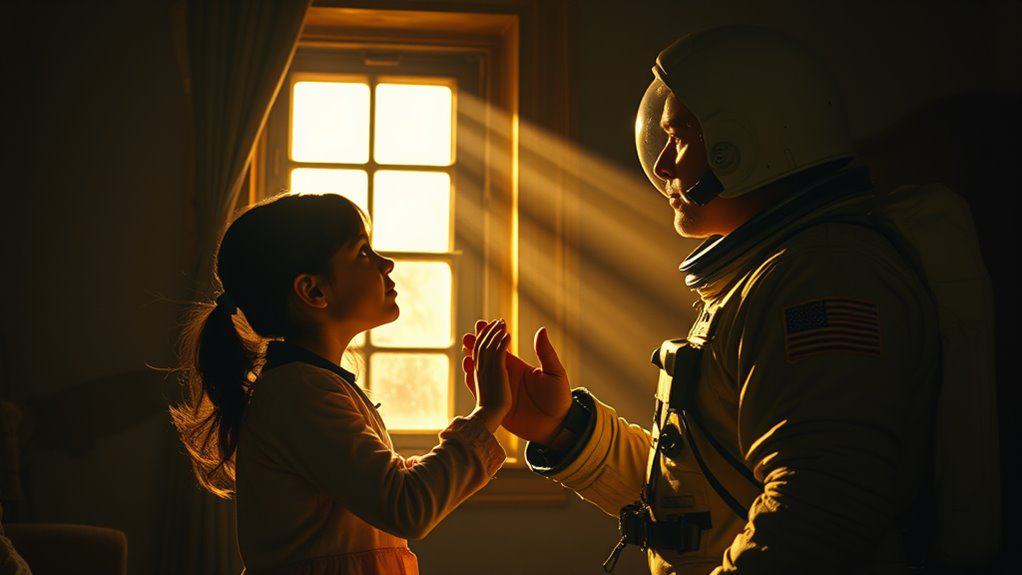
While the vastness of space and time poses challenges, love emerges as a powerful force that transcends these barriers in “Interstellar.” The film illustrates that love isn’t just an emotion; it acts as an essential power that shapes human actions and decisions. You see this through Cooper’s unwavering commitment to Murph, a bond that illustrates love’s universality and evolution.
Here are three key aspects of love in the film:
- Transcendence: Love defies the limitations of time and space, influencing choices across vast distances.
- Sacrifice: Cooper’s departure from Earth embodies love’s selfless nature, as he puts the survival of humanity above his desires.
- Complexity: The film contrasts Cooper and Dr. Brand’s views on love, showcasing its multifaceted nature.
Ultimately, “Interstellar” suggests that love isn’t merely a feeling; it’s a driving force that compels individuals to act for the greater good.
As you explore these themes, you’ll find that love, in its many forms, plays a crucial role in shaping human behavior and decisions, reminding us of our profound connections to one another.
Personal Reflections on Their Bond

The emotional depth of Cooper and Murph’s bond is a tribute to the complexities of love experienced in “Interstellar.” Their relationship is shaped by shared experiences, both joyful and painful, that illustrate how love can drive individuals to endure hardship and sacrifice.
You can see this through their bonding moments, where their mutual support fuels their growth, despite the physical and temporal barriers separating them. Cooper’s departure ignites a profound mix of hope and despair in Murph, leading to her emotional turmoil and eventual resilience.
Throughout the film, the reconciliation scenes highlight the transformative power of their love. Murph’s anger towards Cooper evolves into understanding as she grapples with her own challenges.
Their parallel journeys emphasize that love isn’t just about proximity; it’s about connection and the shared intent to support one another, even from afar. As the climax unfolds within the tesseract, their bond shines through as they communicate across dimensions, proving that love can transcend any obstacle.
Ultimately, their reunion serves as a demonstration of the enduring nature of their relationship, showcasing how, despite all odds, love remains a powerful force capable of healing and uniting.
Conclusion
In the vast tapestry of “Interstellar,” Cooper and Murph’s bond weaves a poignant narrative, illustrating how love transcends time and space. Their relationship, marked by sacrifice and emotional depth, serves as an allegory for the enduring connections that define us. As the clock ticks differently for them, we see that true strength lies in the courage to let go, yet hold on to hope. Ultimately, their journey invites us to reflect on our own ties that bind, echoing across the cosmos.


